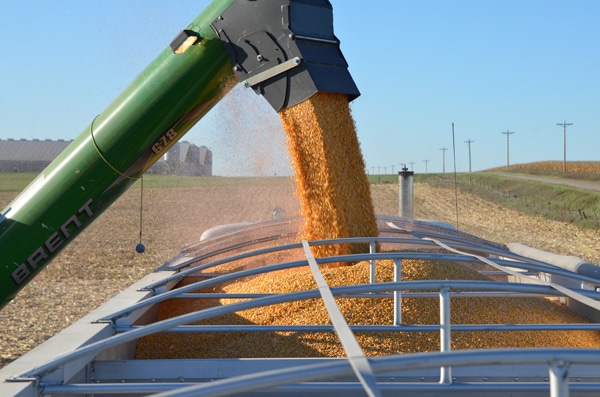October 13, 2015

The USDA's October 9 Crop Production report forecast the 2015 U.S. corn crop at 13.555 billion bushels, 30 million bushels smaller than the September forecast and 660 million bushels smaller than the 2014 crop. The U.S. average corn yield is forecast at 168 bushels, 0.5 bushel above the September forecast, and harvested acreage is forecast at 80.664 million, 437,000 below the September forecast.
Commentary following the release of the report suggests that some observers believe the corn crop is not as large as the current USDA forecast. One of the factors cited as evidence is the strong basis levels in many markets. The average cash price at central Illinois country elevators on October 9, for example, was 16¢ under December futures. A year earlier, the average basis at those locations was 42¢. The argument is that a crop as large as forecast, particularly in the face of a rapid pace of harvest and a large soybean crop, would not support such a strong basis due to the resulting strong demand for storage space.
That argument, however, is not completely supported by the current estimates of crop supplies. Total supplies of corn and soybeans in areas experiencing the strongest basis are in fact estimated to be much smaller than supplies of a year ago, which would tend to support basis levels relative to those of last year. Forecast production of those two crops plus the inventory of the old crop on September 1, is estimated to be down 196 million bushels (7 percent) in Illinois, 219 million bushels (17 percent) in Indiana, 188 million bushels (26 percent) in Missouri, and 67 million bushels (8 percent) in Ohio.
In contrast, supplies are up 189 million bushels (6 percent) in Iowa and 344 million bushels (17 percent) in Minnesota. Nationally, the total supply of corn and soybeans (production plus September 1 stocks) is estimated to be 100 million bushels smaller than the supply of a year ago. While harvest progress during the first week of October was more rapid than that of last year, it was equal to the average pace in the previous 5-years and cumulative harvest was five percentage points behind the average level.
Basis level influence
Basis levels are generally determined by the supply of storage space and an array of factors that determine the demand for storage capacity. Harvest-time basis levels at the point of producer delivery may be receiving some additional support this year from the recent expansion in grain storage capacity. The USDA's December Grain Stocks report, for example, estimates that permanent storage capacity (on- and off- farm) increased by nearly 550 million bushels from December 1, 2012 to December 1, 2014. Additional capacity has been added in the past year. Basis levels at the farm level may also be receiving support from the lack of widespread transportation delays and the increasing use of delayed pricing contracts.
Both of these factors allow for a more rapid movement of corn through the marketing channel. The lack of widespread transportation issues may reflect, in part, the dominance of the domestic corn market relative to exports resulting in a larger portion of the crop moving by truck rather than by rail where delays are more common.
Basis levels are also influenced by the pace of corn consumption. A more rapid pace of consumption, all else equal, tends to strengthen basis in order to make storage less attractive. Domestic ethanol production in September and early October 2015 was nearly 5 percent larger than that of a year earlier, supporting the domestic demand for corn. Domestic feed demand for corn has also likely been supported by the four percent increase in the hog inventory this fall and the slightly larger number of cattle on feed, dairy cattle, and broiler placements. On the other hand, the pace of export shipments is well below that of last year. The relative pace of consumption in the various segments of the corn market may explain part of the regional differences in basis patterns this year.
Since corn basis levels and patterns are determined by a complex set of supply and demand factors, it seems to be a stretch to conclude that generally strong harvest time basis levels this year point to a smaller corn crop than currently forecast.
History is also not on the side of a smaller yield forecast than the 168-bushel forecast of last week. In the 40 years from 1975 through 2014, the USDA yield forecast increased from September to October, as it did this year, in 24 years. The January yield estimate was below the October forecast in only four of those 24 years. The decline was 0.2 bushel in 1991, 0.1 bushel in 2008, 1.6 bushels in 2013, and 3.2 bushels in 2014. In 2013, a yield forecast was not released in October due to the partial government shutdown, so the yield change was from November to January. The November to January decline in the yield forecast of 1.6 bushels that year followed a very large September to November increase of 5.1 bushels. The 3.2 bushel decline in 2014 followed a September to October increase of 2.5 bushels.
While higher corn prices as the marketing year progresses are possible, price increases are not likely to be generated by a smaller U.S. production forecast. Instead, prices will be influenced by the pace of consumption and the development of the South American crop.
You May Also Like




